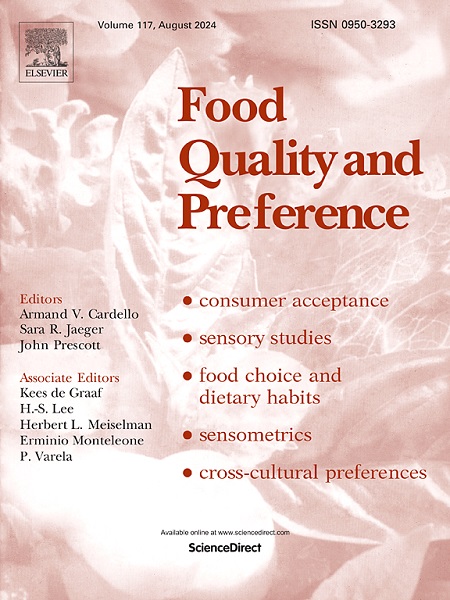From virtual reality visuals to real food perception: Uncovering the link between food aesthetics and taste in Chinese female consumers
IF 4.9
1区 农林科学
Q1 FOOD SCIENCE & TECHNOLOGY
引用次数: 0
Abstract
Previous research has shown that visual information presented in the digital space can influence consumers' perceptions and evaluations of real food. We conducted two experiments to examine how virtual food plating might influence participants' ratings of taste, pleasantness, and purchase intention for real food, as well as to pinpoint the boundary conditions of these cross-reality effects. In Experiment 1, forty participants tasted real food while simultaneously viewing either aesthetically or casually plated virtual food. The real and virtual food could be either of the same type or different types. Virtual food plating exerted an influence on the taste ratings of both types of real food. However, it only influenced the ratings of pleasantness and purchase intention for real food when the virtual and real food were of the same type. In Experiment 2, following the same experimental procedure, forty participants evaluated two types of food with distinct flavors, varying levels of familiarity, yet comparable preference ratings. Virtual food plating only affected the participants' taste ratings for food with delicate flavors. Moreover, the cross-reality effects on ratings of taste, pleasantness, and purchase intention emerged only when the participants were less familiar with the food. Collectively, these findings demonstrate that aesthetic cues from the digital space can be integrated with sensory experiences from the physical space, thereby influencing the evaluations of real food. These findings offer marketers insights into leveraging virtual reality technology to enhance consumers' dining experiences.
从虚拟现实视觉到真实的食物感知:揭示中国女性消费者的食物审美与味觉之间的联系
先前的研究表明,数字空间中呈现的视觉信息可以影响消费者对真实食品的感知和评价。我们进行了两个实验来研究虚拟食物如何影响参与者对真实食物的味道、愉悦度和购买意愿的评级,并确定这些跨现实效应的边界条件。在实验1中,40名参与者品尝了真正的食物,同时观看了美观或随意摆放的虚拟食物。真实的和虚拟的食物可以是相同的类型,也可以是不同的类型。虚拟餐盘对两种真实食物的味道评分都有影响。然而,只有当虚拟食物和真实食物的类型相同时,它才会影响对真实食物的愉悦度评分和购买意愿。在实验2中,遵循相同的实验程序,40名参与者评估两种不同口味的食物,熟悉程度不同,但偏好等级相似。虚拟食物盘子只影响了参与者对味道微妙的食物的味觉评分。此外,只有当参与者对食物不太熟悉时,他们对味道、愉悦度和购买意愿的评分才会出现跨现实效应。总的来说,这些发现表明,来自数字空间的审美线索可以与来自物理空间的感官体验相结合,从而影响对真实食物的评价。这些发现为营销人员提供了利用虚拟现实技术增强消费者用餐体验的见解。
本文章由计算机程序翻译,如有差异,请以英文原文为准。
求助全文
约1分钟内获得全文
求助全文
来源期刊

Food Quality and Preference
工程技术-食品科技
CiteScore
10.40
自引率
15.10%
发文量
263
审稿时长
38 days
期刊介绍:
Food Quality and Preference is a journal devoted to sensory, consumer and behavioural research in food and non-food products. It publishes original research, critical reviews, and short communications in sensory and consumer science, and sensometrics. In addition, the journal publishes special invited issues on important timely topics and from relevant conferences. These are aimed at bridging the gap between research and application, bringing together authors and readers in consumer and market research, sensory science, sensometrics and sensory evaluation, nutrition and food choice, as well as food research, product development and sensory quality assurance. Submissions to Food Quality and Preference are limited to papers that include some form of human measurement; papers that are limited to physical/chemical measures or the routine application of sensory, consumer or econometric analysis will not be considered unless they specifically make a novel scientific contribution in line with the journal''s coverage as outlined below.
 求助内容:
求助内容: 应助结果提醒方式:
应助结果提醒方式:


